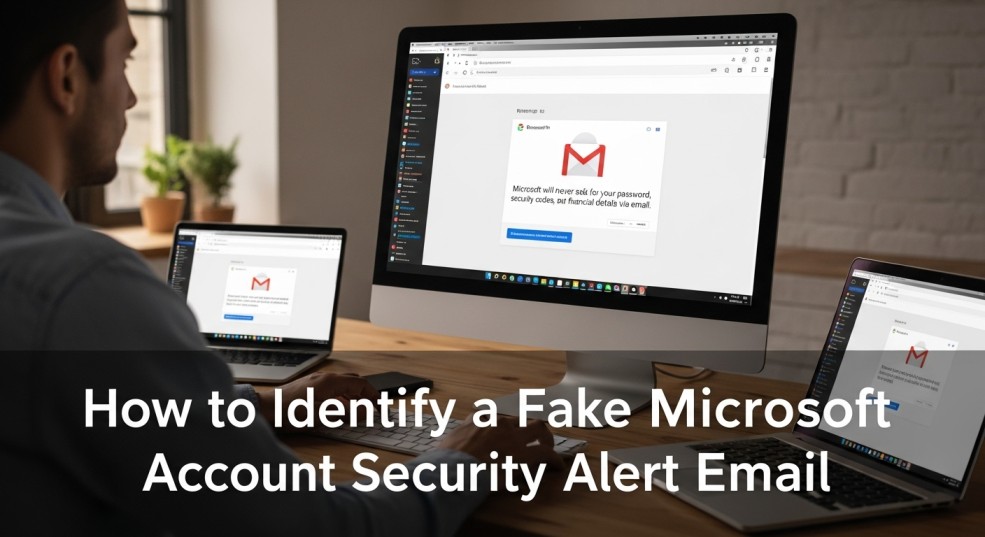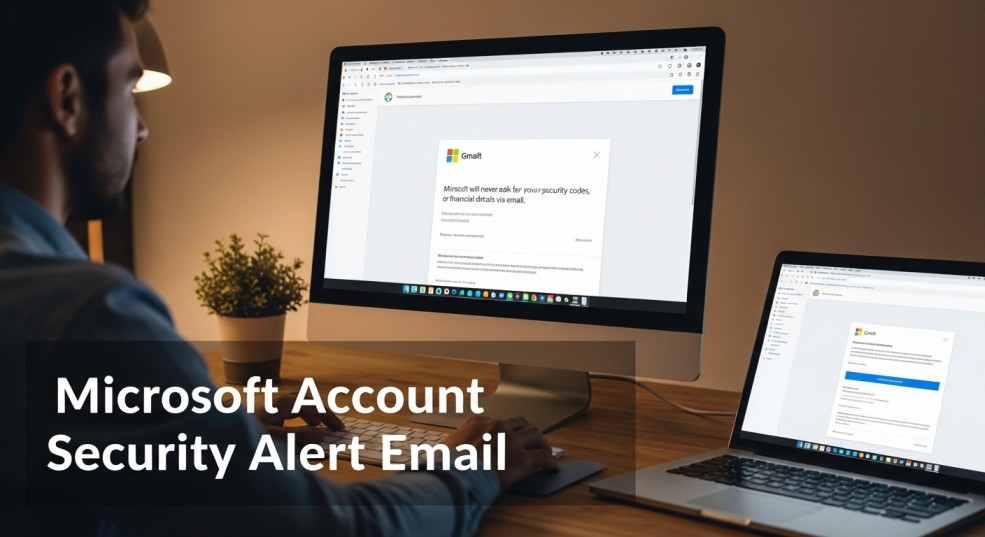Understanding Microsoft Account Security Alerts: What You Need to Know
Microsoft account security alerts are designed to inform you of unusual activity, like suspicious sign-ins or password changes. However, cybercriminals exploit these alerts through sophisticated phishing scams to steal your personal information, including passwords, financial data, and more.
This comprehensive guide will equip you with the knowledge to differentiate between legitimate Microsoft alerts and fraudulent ones, ensuring your account's safety. Staying informed and vigilant is crucial in today's digital landscape.
Spotting How to Identify a Fake Microsoft Account Security Alert Email
Recognizing a phishing email is your first line of defense. Here's how to spot the red flags:
1. Check the Sender’s Email Address: Legitimate emails from Microsoft *always* originate from official domains like @accountprotection.microsoft.com, @microsoft.com, or @email.microsoft.com. Beware of subtle misspellings, such as 'micrsoft.com' or unrelated domains. Always verify the sender.
2. Look for Red Flags in the Content: Phishing emails often employ urgent or threatening language (e.g., 'Immediate action required'). Generic greetings (e.g., 'Dear User') are common, whereas Microsoft typically uses your full name. Poor grammar and spelling mistakes are also telltale signs.
3. Beware of Suspicious Links or Attachments: Hover your mouse *over* links (without clicking!) to reveal the actual URL. Legitimate links will point to Microsoft domains. Never click links or download attachments from suspicious emails.
4. Verify the Email’s Purpose: Legitimate alerts will inform you of specific actions, like unusual sign-in attempts. Scams often request personal information, passwords, or payment details – which Microsoft *never* asks for via email.
Immediate Actions to Take if You Receive a Suspicious Alert
If you suspect a phishing attempt, take these immediate steps:
1. Do NOT Click Any Links or Attachments: Clicking could lead to malicious websites designed to steal your data. Instead, open a new browser tab and manually type in Microsoft's official website (microsoft.com).
2. Check Your Account Activity Directly: Log into your Microsoft account directly and navigate to the 'Recent Activity' section to review any legitimate alerts or unusual sign-in attempts.
3. Change Your Password and Enable 2FA: Immediately change your password using a strong, unique phrase with letters, numbers, and symbols. Enable Two-Factor Authentication (2FA) for an extra layer of security (e.g., a code sent to your phone).
4. Report the Phishing Attempt: Forward the suspicious email *as an attachment* to [protected email]. Use the 'Report phishing' option in your email client (Outlook, etc.) to alert Microsoft.
5. Monitor Your Accounts: Regularly review your financial and Microsoft accounts for unauthorized activity. Contact your bank or Microsoft Support immediately if you find anything suspicious.
Strengthening How to Fortify Your Microsoft Account Security
Enhance your account's security with these preventative measures:
1. Enable Two-Factor Authentication (2FA): 2FA significantly reduces the risk of unauthorized access, even if your password is compromised. This adds an extra layer of verification.
2. Use Strong, Unique Passwords: Avoid reusing passwords across multiple sites. Consider using a password manager to generate and store complex, unique passwords.
3. Keep Software Updated: Regularly update your operating system and security software to protect against the latest vulnerabilities. Patches are crucial!
4. Educate Yourself and Others: Stay informed about the latest phishing tactics, and share your knowledge with friends, family, and colleagues to help protect them as well. Be proactive!
“Never share passwords or financial details via email. Verify alerts by logging into your account directly.
Security Best Practice
Interactive Tools and Resources
Explore these helpful elements to stay safe!
Phishing Email Checker
Upload a suspicious email for a quick analysis. Get instant feedback on potential threats!
Account Security Checklist
Download our interactive checklist to ensure your account is properly secured.
Report a Phishing Attempt
Directly report phishing emails to the Microsoft security team.
Key Differences Between Legitimate and Scam Emails
Here's a quick reference guide:
| Feature | Legitimate Microsoft Email | Scam Microsoft Email |
|-----------------------|-------------------------------------------------|----------------------------------------------------------|
| Sender's Address | Official Microsoft domain (e.g., @accountprotection.microsoft.com) | Slight misspellings or unrelated domains (e.g., micrsoft.com) |
| Greeting | Personalized with your full name | Generic (e.g., 'Dear User' or 'Dear Customer') |
| Language | Professional and clear | Urgent or threatening tone |
| Links | Direct to official Microsoft domains | Direct to suspicious or unrelated sites |
| Attachments | Rarely included | Often include malicious attachments |
| Requests for Info | Never asks for passwords or financial details | Asks for sensitive information |
Consider this a visual aid and a quick checklist.
FAQ Frequently Asked Questions About Microsoft Account Security Alerts
Does Microsoft send security alerts via email? Yes, but *never* asks for passwords or financial details. Always verify by logging into your account directly.
What should I do if I click a link in a suspicious email? Change your password immediately, run a virus scan, and monitor your accounts for unusual activity.
How can I report a phishing email? Forward it to [protected email] or use the 'Report phishing' option in your email client.
Can I prevent these emails from reaching my inbox? Use email filters and enable built-in spam detection to reduce phishing attempts.
How do I know if a Microsoft security alert email is real? A real alert will *never* ask for your password and comes from the official sender. Check the domain!
Is Gmail linked to a Microsoft account? A Gmail address *can* be used as a Microsoft account username, but they are separate services.
What is the official Microsoft account security email? For security alerts, Microsoft uses @accountprotection.microsoft.com.
How do I know if a security alert from Google is real? Never click links in the email. Go directly to your Google account’s security page.
Is there a fake Microsoft security alert? Yes, fake Microsoft security alerts are a common phishing scam. Be vigilant!
How do I check who is trying to access my Microsoft account? Go to your Microsoft account’s 'Recent activity' page to see all sign-in attempts, locations, and devices.
Why is Microsoft sending me an email about my Gmail account? This is likely a phishing scam. Microsoft will *not* email you about a Gmail account unless the Gmail is used as the Microsoft account username. However, always verify.
What email address does Microsoft use? For security alerts, Microsoft uses @accountprotection.microsoft.com.
How to access Microsoft account with Gmail? Use your Gmail address (if it’s your Microsoft account username) to sign in on Microsoft’s official login page.
Why did I receive a Microsoft verification code but didn’t request it? Someone likely has your password. Change your password immediately.
What is the name of the Microsoft email security? Microsoft's enterprise email security service is called Microsoft Defender for Office 365.
What can someone do with your Microsoft account? They can access your email, files, and payment info, and use your account to scam contacts.
Conclusion Stay Vigilant and Secure
Microsoft Account Security Alert Emails are essential for protecting your account, but scammers exploit them to deceive users. By following the steps outlined in this guide – verifying the sender, checking content, and never sharing sensitive information – you can confidently identify scams, take immediate action to secure your account, and prevent future threats.
Remember: Never share passwords or financial details via email. Verify alerts by logging into your account directly. Enable Two-Factor Authentication for enhanced security. Report suspicious emails to help protect others. Stay informed and proactive to safeguard your digital life. If in doubt, contact Microsoft Support through their official website for assistance.